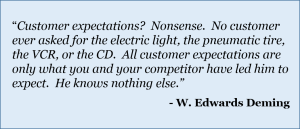“The basis of the
Toyota production system is the absolute elimination of waste.” – Taiichi Ohno
Every now and then, I like to go back and reread books I’ve
read in the past to be reminded of important points that I’ve either forgotten
or just missed the first time around. This
is particularly true of books by, or related to W. Edwards Deming, Peter
Drucker, and Taiichi Ohno. Recently, I reread
Ohno’s The Toyota Production System: Beyond Large-Scale Production. Each time I read this book, I get a better
understanding of the thinking behind the development of TPS, including how I
can address a number of organizational problems I face that I’ve been unable to
resolve.
This time around, though, there was one point that kept
coming up and I couldn’t get past.
Throughout the book, Ohno repeats the idea the TPS is completely about eliminating
waste. The issue I had with this is
that, in my experience, people who focus lean efforts only on waste tend to get
overly focused on the tools and end up working a number of disconnected
problems that result in little sustained improvement.
A more subtle message in the book that I don’t believe gets as
much attention as the elimination of
waste is the challenge that Kiichiro Toyoda put forth regarding the need to
“catch up with America in three years.” Ohno
writes very fondly about Toyoda, including how important he was to Japanese
industry and the development of TPS. He
credits Toyoda’s statement as being inspirational, but rather than being the
drive for the development of TPS, translates it into a call for the elimination
of waste.
So Much More than
Waste
Perhaps Ohno’s view of waste is more complex than most
people can truly comprehend, but I think that the message of using lean to
reduce waste has gotten so watered down that most companies fail to achieve the
big gains that a true transformation can achieve.
When the focus is waste reduction, lean can easily become a
toolbox to reduce costs. In my
experience, every organization that turns its lean effort toward cost reduction
fails to sustain the improvements and eventually drops the effort when something
else draws its attention.
I contend that the focus of lean should be the company’s
vision. This assumes that the
organization has a vision and that it’s truly inspirational. In Toyota’s case, the vision was to catch up with America. Other companies that have been successful
with lean tend to have equally inspirational vision statements.
Deming said that a company’s vision is a value judgement and
must include plans for the future. This
means that it includes much more than profits or share price. It must relate to providing better and better
value to the company’s stakeholders, including customers, employees, suppliers,
the community, and shareholders. It is the
focus on improving the value to all stakeholders to a level never before
achieved (or even conceived) that provides inspiration.
When the organization has a clear statement that inspires
people, lean becomes the vehicle to make it happen. It provides a method for everyone in the
organization to align efforts and work together to drive sustained and
never-ending improvement. The effort
begins with the vision and translates it into more and more detail as it works through
the company’s long-term objectives, annual plans, dashboards, meeting rhythm,
and daily problem-solving.
It is through the alignment of these efforts, beginning with
a clear and inspirational vision, that lean enables innovation and an obsessive
focus on closing the gaps that are truly important to the organization. And when lean efforts are anchored by the
vision, people will not be distracted by the numerous management fads that can
derail the effort.
What Did Ohno Mean?
We’ll never get inside of Ohno’s head to understand whether
or not the vision of catching up to
America in three years is what truly inspired the development of TPS. It is only my interpretation that the vision
is what leads to sustained gains and what drives lean at Toyota. Perhaps I’ll see this more clearly the next
time I read the book . . . or perhaps I’ll find something else I completely
missed this time.





